-
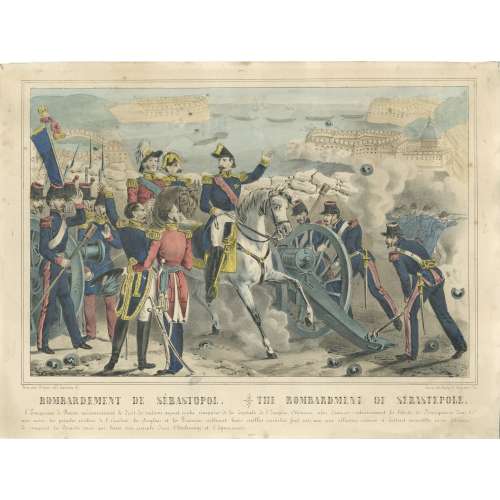 Hand-coloured lithography on wove paper, 250 x 332 mm; black ink stamp “5035” to reverse. Under the frame left: "Paris, chez Riboni, éd. r. Galande, 51"; right: "Paris, lith. Bulla, Pl. Maubert, 26". Below: "BOMBARDEMENT DE SEBASTOPOL. — THE BOMBARDMENT OF SÉBASTOPOLE". Text to bottom. Printers/publishers: Antoine Bulla (fl. 1815 – 1877), François Bulla (fl. c. 1814 – 1855).
Hand-coloured lithography on wove paper, 250 x 332 mm; black ink stamp “5035” to reverse. Under the frame left: "Paris, chez Riboni, éd. r. Galande, 51"; right: "Paris, lith. Bulla, Pl. Maubert, 26". Below: "BOMBARDEMENT DE SEBASTOPOL. — THE BOMBARDMENT OF SÉBASTOPOLE". Text to bottom. Printers/publishers: Antoine Bulla (fl. 1815 – 1877), François Bulla (fl. c. 1814 – 1855). -
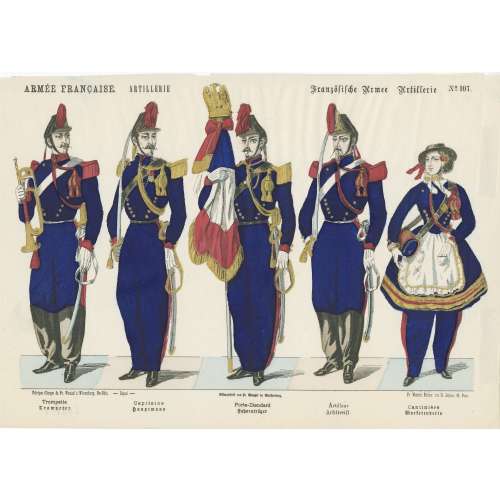 Hand-coloured woodcut on wove paper, 265 x 378 mm; black ink stamp “5051 1” to reverse. Top left: "ARMÉE FRANCAISE. ARTILLERIE"; right: (gothic font) "Französische Armee Artillerie" — "№ 107". Below left: "Fabrique d’Images de Fr. Wentzel à Wissembeurg. Bas-Rhin." — "Déposé" —, centre: "Bilderfabrit von Fr. Wentzel in Weissenburg", right: "Fr. Wentzel, Éditeur, rue St. Jacques, 65, Paris". Bottom: "Trompette | Trompeter" — "Capitaine | Gauptmann" — "Porte-Étendard | Fahnenträger" — "Artilleur | Artillerist" — "Cantinière | Marketenderin". Jean Frédéric Wentzel (French, 1807 – 1869) – publisher/printer.
Hand-coloured woodcut on wove paper, 265 x 378 mm; black ink stamp “5051 1” to reverse. Top left: "ARMÉE FRANCAISE. ARTILLERIE"; right: (gothic font) "Französische Armee Artillerie" — "№ 107". Below left: "Fabrique d’Images de Fr. Wentzel à Wissembeurg. Bas-Rhin." — "Déposé" —, centre: "Bilderfabrit von Fr. Wentzel in Weissenburg", right: "Fr. Wentzel, Éditeur, rue St. Jacques, 65, Paris". Bottom: "Trompette | Trompeter" — "Capitaine | Gauptmann" — "Porte-Étendard | Fahnenträger" — "Artilleur | Artillerist" — "Cantinière | Marketenderin". Jean Frédéric Wentzel (French, 1807 – 1869) – publisher/printer. -
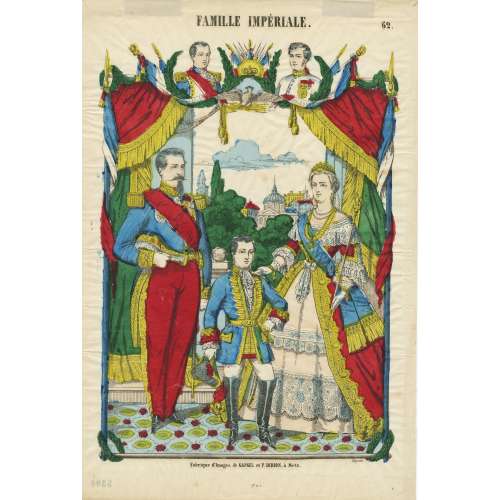 Hand-coloured woodcut on wove paper, 400 x 270 mm; black ink stamp “5306” to reverse. Top centre: "FAMILLE IMPÉRIALE", right: "62."; below centre: "Fabrique d'Images de GANGEL et P. DIDION, à Metz."; right: "Déposé." Publisher/printer: Gangel et P. Didion (Metz); Paulin Didion (French, 1831 – 1879). Characters: Napoleon III [Charles-Louis Napoléon Bonaparte] (French, 1808 – 1873) Eugénie de Montijo [L'impératrice Eugénie] (Spanish-French, 1826 – 1920) Napoléon, Prince Imperial (Napoléon Eugène Louis Jean Joseph Bonaparte] (French, 1856 – 1879) Napoléon II [Napoléon François Joseph Charles Bonaparte] (French, 1811 – 1832) Napoléon Ier [Napoléon Bonaparte] (French, 1769 – 1821)
Hand-coloured woodcut on wove paper, 400 x 270 mm; black ink stamp “5306” to reverse. Top centre: "FAMILLE IMPÉRIALE", right: "62."; below centre: "Fabrique d'Images de GANGEL et P. DIDION, à Metz."; right: "Déposé." Publisher/printer: Gangel et P. Didion (Metz); Paulin Didion (French, 1831 – 1879). Characters: Napoleon III [Charles-Louis Napoléon Bonaparte] (French, 1808 – 1873) Eugénie de Montijo [L'impératrice Eugénie] (Spanish-French, 1826 – 1920) Napoléon, Prince Imperial (Napoléon Eugène Louis Jean Joseph Bonaparte] (French, 1856 – 1879) Napoléon II [Napoléon François Joseph Charles Bonaparte] (French, 1811 – 1832) Napoléon Ier [Napoléon Bonaparte] (French, 1769 – 1821) -
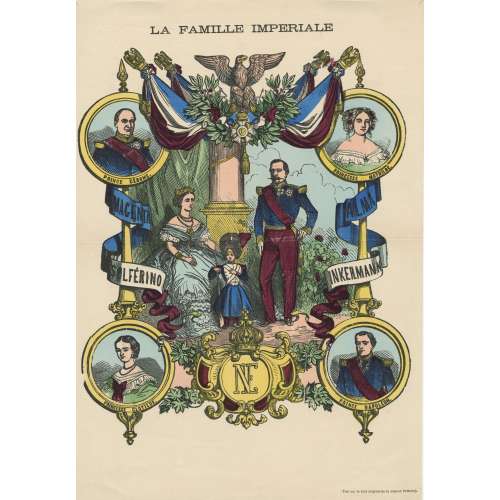 Hand-coloured woodcut on laid paper, 422 x 294 mm; black ink stamp “5307” to reverse, centrefold. Top center: "LA FAMILLE IMPERIALE"; Bottom right: "(Tire sur le bois original de maison Pellerin)". Image: Napoléon III, Empress Eugenie, and Prince Imperial Louis-Napoléon as a child surrounded with four lettered medallions: “PRINCE GÉROME”, “PRINCESSE MATHILDE”, “PRINCESSE CLOTILDE”, and “PRINCE NAPOLÉON”; ribbons lettered: “MAGENTA”, SOLFERINO”, “ALMA”, and “INKERMANN” around heraldic spears; coat of arms with imperial monogram between Princesse Clotilde and Prince Napoléon. Publisher/printer: Jean Charles Pellerin (French, 1756 – 1836). Battle of Magenta : 4 June 1859, against the Austrians. Battle of Solferino : 24 June 1859, against the Austrians. Battle of the Alma : 20 September 1854 (Crimean War) Battle of Inkerman : 5 November 1854 (Crimean War) Characters: Napoleon III [Charles-Louis Napoléon Bonaparte] (French, 1808 – 1873) Eugénie de Montijo [L'impératrice Eugénie] (Spanish-French, 1826 – 1920) Napoléon, Prince Imperial (Napoléon Eugène Louis Jean Joseph Bonaparte] (French, 1856 – 1879) Napoléon-Jérôme Bonaparte [Prince Jérôme] (French, 1822 – 1891) Mathilde Bonaparte [Princess Mathilde] (French, 1820 – 1904) Marie-Clotilde de Savoie [Princesse Clotilde] (French, 1843 – 1911)
Hand-coloured woodcut on laid paper, 422 x 294 mm; black ink stamp “5307” to reverse, centrefold. Top center: "LA FAMILLE IMPERIALE"; Bottom right: "(Tire sur le bois original de maison Pellerin)". Image: Napoléon III, Empress Eugenie, and Prince Imperial Louis-Napoléon as a child surrounded with four lettered medallions: “PRINCE GÉROME”, “PRINCESSE MATHILDE”, “PRINCESSE CLOTILDE”, and “PRINCE NAPOLÉON”; ribbons lettered: “MAGENTA”, SOLFERINO”, “ALMA”, and “INKERMANN” around heraldic spears; coat of arms with imperial monogram between Princesse Clotilde and Prince Napoléon. Publisher/printer: Jean Charles Pellerin (French, 1756 – 1836). Battle of Magenta : 4 June 1859, against the Austrians. Battle of Solferino : 24 June 1859, against the Austrians. Battle of the Alma : 20 September 1854 (Crimean War) Battle of Inkerman : 5 November 1854 (Crimean War) Characters: Napoleon III [Charles-Louis Napoléon Bonaparte] (French, 1808 – 1873) Eugénie de Montijo [L'impératrice Eugénie] (Spanish-French, 1826 – 1920) Napoléon, Prince Imperial (Napoléon Eugène Louis Jean Joseph Bonaparte] (French, 1856 – 1879) Napoléon-Jérôme Bonaparte [Prince Jérôme] (French, 1822 – 1891) Mathilde Bonaparte [Princess Mathilde] (French, 1820 – 1904) Marie-Clotilde de Savoie [Princesse Clotilde] (French, 1843 – 1911) -
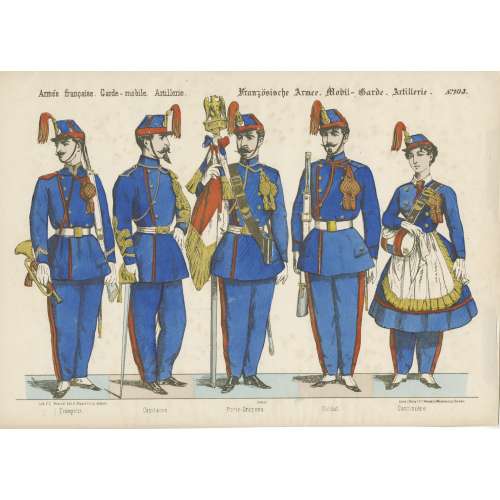 Hand-coloured woodcut on wove paper, 282 x 392 mm; black ink stamp “5051 2” to reverse. Top: "Armée française. Garde–mobile. Artillerie." — (gothic font) "Französische Armee. Mobil–Garde. Artillerie." — "№103". Below left: "Lith F. C. Wentzel édit. à Wissembourg. (Alsacé); center: Déposé; right: Druck u. Verlag v. F. C. Wentzel in Weissemburg. (Elsass)."; Bottom: "Trompette" — "Capitaine" — "Porte-Drapeau". — "Soldat" — "Cantinière." Jean Frédéric Wentzel (French, 1807 – 1869) – publisher/printer.
Hand-coloured woodcut on wove paper, 282 x 392 mm; black ink stamp “5051 2” to reverse. Top: "Armée française. Garde–mobile. Artillerie." — (gothic font) "Französische Armee. Mobil–Garde. Artillerie." — "№103". Below left: "Lith F. C. Wentzel édit. à Wissembourg. (Alsacé); center: Déposé; right: Druck u. Verlag v. F. C. Wentzel in Weissemburg. (Elsass)."; Bottom: "Trompette" — "Capitaine" — "Porte-Drapeau". — "Soldat" — "Cantinière." Jean Frédéric Wentzel (French, 1807 – 1869) – publisher/printer. -
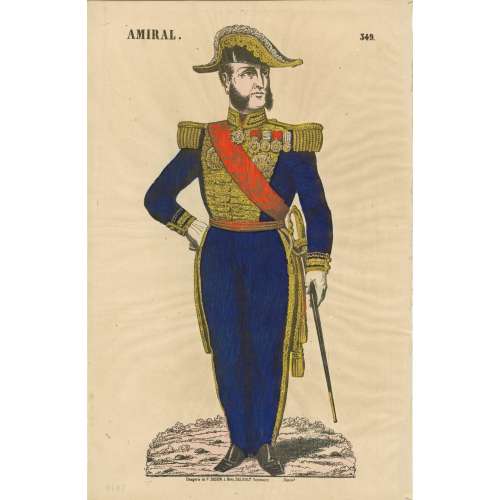 Hand-coloured woodcut on wove paper, 440 x 285 mm; black ink stamp “5049” to reverse. Top left: "AMIRAL"; right: "349". Below: "Imagerie de DIDION, à Metz, DELHALT Successeur." — "Déposé." Paulin Didion (French, 1831 – 1879) – publisher/printer.
Hand-coloured woodcut on wove paper, 440 x 285 mm; black ink stamp “5049” to reverse. Top left: "AMIRAL"; right: "349". Below: "Imagerie de DIDION, à Metz, DELHALT Successeur." — "Déposé." Paulin Didion (French, 1831 – 1879) – publisher/printer. -
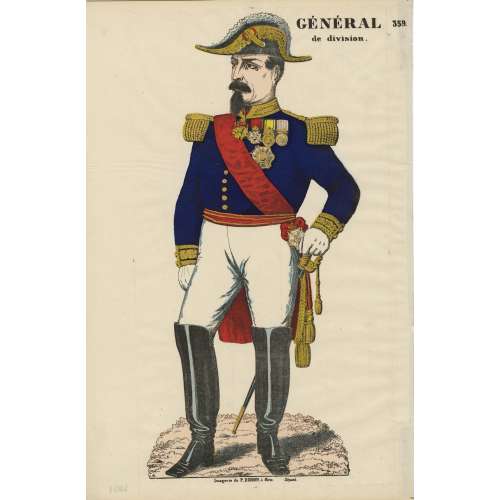 Hand-coloured woodcut on wove paper, 430 x 285 mm; black ink stamp “5051” to reverse. Top right: "GÉNÉRAL | de division." — "359." Bottom: "Imagerie de DIDION, à Metz. Déposé." Paulin Didion (French, 1831 – 1879) – publisher/printer.
Hand-coloured woodcut on wove paper, 430 x 285 mm; black ink stamp “5051” to reverse. Top right: "GÉNÉRAL | de division." — "359." Bottom: "Imagerie de DIDION, à Metz. Déposé." Paulin Didion (French, 1831 – 1879) – publisher/printer. -
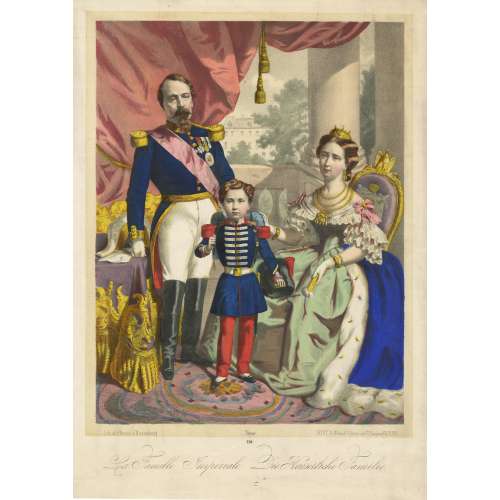 Hand-coloured lithography on wove paper, 395 x 280 mm; black ink stamp “5309” to reverse. On image: artist's initials "L. H."; on stone: "Lith. de Fr. Wentzel a Wissembourg. — Déposé — DÉPÔT, Fr. Wentzel Editeur rue St. Jacques 65, PARIS"; below centre: "239"; bottom : La famille Impériale. Die Kaizerliche Familie. Napoleon III [Charles-Louis Napoléon Bonaparte] (French, 1808 – 1873) Eugénie de Montijo [L'impératrice Eugénie] (Spanish-French, 1826 – 1920) Napoléon, Prince Imperial (Napoléon Eugène Louis Jean Joseph Bonaparte] (French, 1856 – 1879) Jean Frédéric Wentzel (French, 1807 – 1869) – publisher/printer.
Hand-coloured lithography on wove paper, 395 x 280 mm; black ink stamp “5309” to reverse. On image: artist's initials "L. H."; on stone: "Lith. de Fr. Wentzel a Wissembourg. — Déposé — DÉPÔT, Fr. Wentzel Editeur rue St. Jacques 65, PARIS"; below centre: "239"; bottom : La famille Impériale. Die Kaizerliche Familie. Napoleon III [Charles-Louis Napoléon Bonaparte] (French, 1808 – 1873) Eugénie de Montijo [L'impératrice Eugénie] (Spanish-French, 1826 – 1920) Napoléon, Prince Imperial (Napoléon Eugène Louis Jean Joseph Bonaparte] (French, 1856 – 1879) Jean Frédéric Wentzel (French, 1807 – 1869) – publisher/printer. -
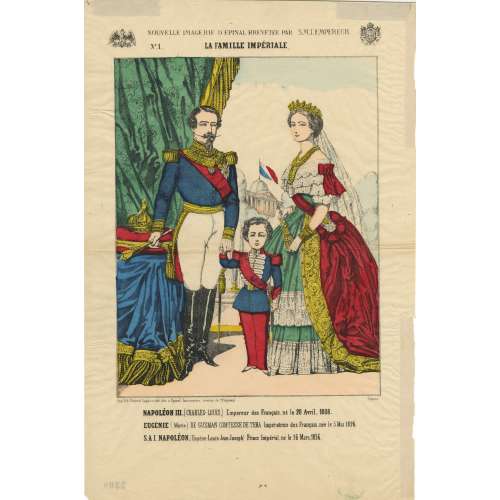 Hand-coloured woodcut on wove paper, 390 x 260 mm; black ink stamp “5308” to reverse; horizontal centerfold. Centre top: "NOUVELLE IMAGERIE D'ÉPINAL BREVETÉE PAR S.M.L’EMPEREUR" with imperial eagle and coat of arms at right and left. Below: "№ 1." — "LA FAMILLE IMPÉRIALE"; image in frame; under the image, left: "Imp lith. Pinot & Sagaire, édit. libr. à Épinal, fournisseurs brevetés de l’Empereur"; right: "Déposé". Bottom: "NAPOLÉON I. (CHARLES-LOUIS,) Empereur des Français, né le 20 Avril, 1808. | EUGÉNIE ( Marie) DE GUSMAN COMTESSE DE TEBA Impératrice des Français, née le 5 Mai 1826. | S.A I. NAPOLÉON. (Eugène-Louis-Jean-Joseph) Prince Impérial, ne le 16 Mars. 1856." Napoleon III [Charles-Louis Napoléon Bonaparte] (French, 1808 – 1873) Eugénie de Montijo [L'impératrice Eugénie] (Spanish-French, 1826 – 1920) Napoléon, Prince Imperial (Napoléon Eugène Louis Jean Joseph Bonaparte] (French, 1856 – 1879) Pinot & Sagaire (Épinal, 1861 – 1888) – enterprise, publisher/printer. Charles-François Pinot (French, 1817 – 1879) – publisher/printer.
Hand-coloured woodcut on wove paper, 390 x 260 mm; black ink stamp “5308” to reverse; horizontal centerfold. Centre top: "NOUVELLE IMAGERIE D'ÉPINAL BREVETÉE PAR S.M.L’EMPEREUR" with imperial eagle and coat of arms at right and left. Below: "№ 1." — "LA FAMILLE IMPÉRIALE"; image in frame; under the image, left: "Imp lith. Pinot & Sagaire, édit. libr. à Épinal, fournisseurs brevetés de l’Empereur"; right: "Déposé". Bottom: "NAPOLÉON I. (CHARLES-LOUIS,) Empereur des Français, né le 20 Avril, 1808. | EUGÉNIE ( Marie) DE GUSMAN COMTESSE DE TEBA Impératrice des Français, née le 5 Mai 1826. | S.A I. NAPOLÉON. (Eugène-Louis-Jean-Joseph) Prince Impérial, ne le 16 Mars. 1856." Napoleon III [Charles-Louis Napoléon Bonaparte] (French, 1808 – 1873) Eugénie de Montijo [L'impératrice Eugénie] (Spanish-French, 1826 – 1920) Napoléon, Prince Imperial (Napoléon Eugène Louis Jean Joseph Bonaparte] (French, 1856 – 1879) Pinot & Sagaire (Épinal, 1861 – 1888) – enterprise, publisher/printer. Charles-François Pinot (French, 1817 – 1879) – publisher/printer. -
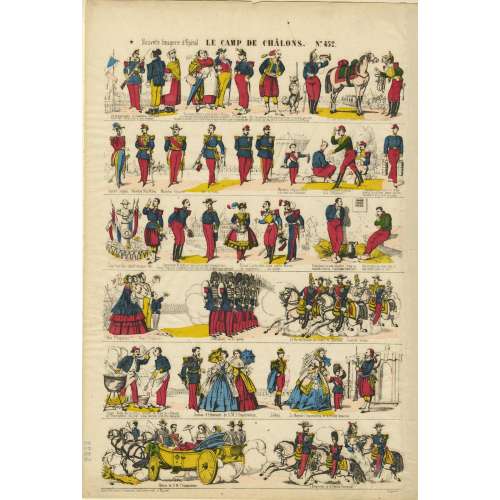 Hand-coloured woodcut on wove paper, 409 x 280 mm; black ink stamp “5323” to reverse; attached to the sheet 487 x 320 mm. Top centre: "LE CAMP DE CHALONS."; left: "Nouvelle Imagerre d'Epinal"; right: № 452. Bottom left: "Imp lith. Pinot & Sagaire, libraires edit. à Épinal"; right: "Déposé". Image: 6-tier cartoon with captions about Napoleon III and his son Prince Imperial (Napoléon Eugène Louis Jean Joseph Bonaparte; 16 March 1856 – 1 June 1879). Le camp de Chalons Pinot & Sagaire (Épinal, 1861 – 1888) – enterprise, publisher/printer. Charles-François Pinot (French, 1817 – 1879) – publisher/printer.
Hand-coloured woodcut on wove paper, 409 x 280 mm; black ink stamp “5323” to reverse; attached to the sheet 487 x 320 mm. Top centre: "LE CAMP DE CHALONS."; left: "Nouvelle Imagerre d'Epinal"; right: № 452. Bottom left: "Imp lith. Pinot & Sagaire, libraires edit. à Épinal"; right: "Déposé". Image: 6-tier cartoon with captions about Napoleon III and his son Prince Imperial (Napoléon Eugène Louis Jean Joseph Bonaparte; 16 March 1856 – 1 June 1879). Le camp de Chalons Pinot & Sagaire (Épinal, 1861 – 1888) – enterprise, publisher/printer. Charles-François Pinot (French, 1817 – 1879) – publisher/printer. -
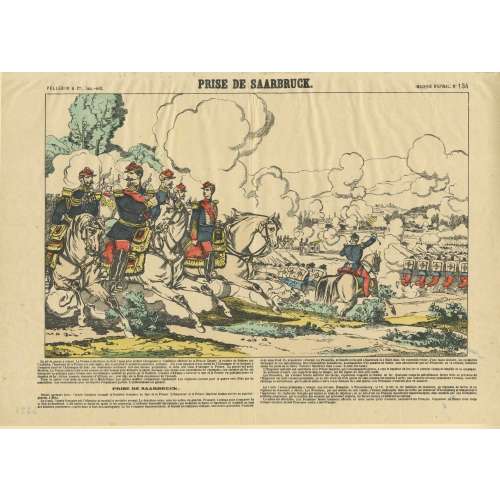 Hand-coloured woodcut on wove paper, 268 x 381 mm, vertical centerfold. On reverse: black ink stamp “5324”. Top centre: "PRISE DE SAARBRUCK"; left: "PELLERIN & Cie, imp. -édit."; right: "IMAGERIE D'EPINAL, № 134." Under the frame text starts with « La cri de guerre a retenti. La France a été forcée de tirer l’épée pour arrêter… ».[...] Prise de Saarbruck. | Depuis quelques jours, l’armée française occupait la frontière française en face de la Prusse.... Jean Charles Pellerin (French, 1756 – 1836) – publisher/printer. The Battle of Saarbrücken (2 August 1870).
Hand-coloured woodcut on wove paper, 268 x 381 mm, vertical centerfold. On reverse: black ink stamp “5324”. Top centre: "PRISE DE SAARBRUCK"; left: "PELLERIN & Cie, imp. -édit."; right: "IMAGERIE D'EPINAL, № 134." Under the frame text starts with « La cri de guerre a retenti. La France a été forcée de tirer l’épée pour arrêter… ».[...] Prise de Saarbruck. | Depuis quelques jours, l’armée française occupait la frontière française en face de la Prusse.... Jean Charles Pellerin (French, 1756 – 1836) – publisher/printer. The Battle of Saarbrücken (2 August 1870). -
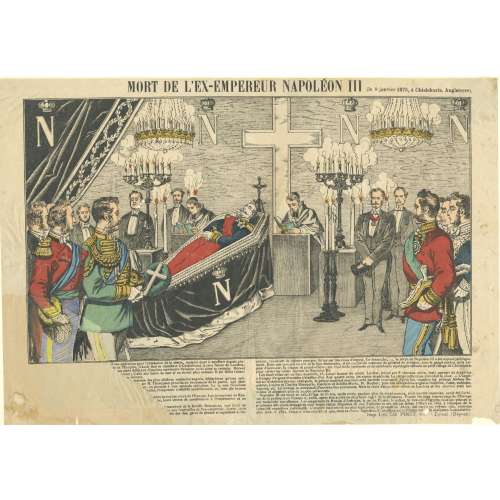 Hand-coloured woodcut on wove paper, 270 x 380 mm; attached to the sheet 303 x 442 mm with pencil ms inscription to the top left corner on the reverse: “Haye le 2-3-75”. Top: "MORT DE L'EX-EMPEREUR NAPOLÉON III (le 9 janvier 1873, à Chislehurts [sic], Angleterre)." Bottom right: "Imp. Lith. CH. PINOT, éditeur. Épinal (Dépose)". Bottom left corner of the image sheet torn and manually restored. Text partially lost, starting with « d’une opération pour l’extraction de la pierre, maladie dont’ il souffrait depuis plu-… ». See Chislehurst. Charles-François Pinot (French, 1817 – 1879) – publisher/printer.
Hand-coloured woodcut on wove paper, 270 x 380 mm; attached to the sheet 303 x 442 mm with pencil ms inscription to the top left corner on the reverse: “Haye le 2-3-75”. Top: "MORT DE L'EX-EMPEREUR NAPOLÉON III (le 9 janvier 1873, à Chislehurts [sic], Angleterre)." Bottom right: "Imp. Lith. CH. PINOT, éditeur. Épinal (Dépose)". Bottom left corner of the image sheet torn and manually restored. Text partially lost, starting with « d’une opération pour l’extraction de la pierre, maladie dont’ il souffrait depuis plu-… ». See Chislehurst. Charles-François Pinot (French, 1817 – 1879) – publisher/printer. -
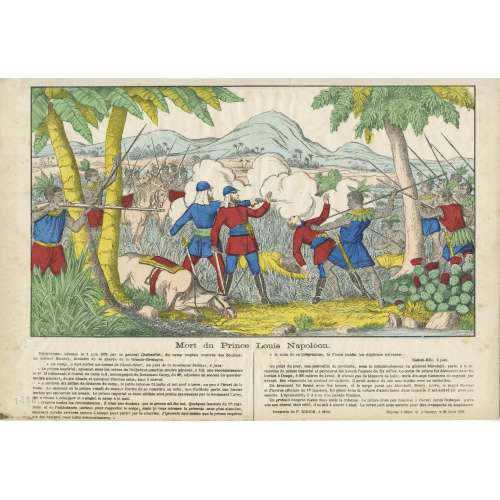 Hand-coloured woodcut on wove paper, 267 x 390 mm. On reverse: black ink stamp “5351”. Centre, under the image frame "Mort du Prince Louis Napoléon". Below left: "Télégramme adressé le 2 juin 1879 par le général Chelmsfort, du camp anglais (contrée des Zoulous), au colonel Stanley, ministre de la guerre de la Grande-Bretagne. « Au camp, à sept milles au-dessus de Blood-River, au pied de la montagne Stellezi, 2 juin: Le prince impérial, agissant sous les ordres de l'adjudant quartier-maitre général. a fait une reconnaissance le 1er. Il retournait à cheval au camp le 2 accompagné du lieutenant Carey, du 98e adjudant en second du quartier-maitre général. de six blancs et, quelques Zoulous amis, tous à cheval. A environ dix milles de distance du camp, la petite colonne fit halte at mit pied à terre, un peu à l’écart de la route. Au moment ou le prince venait de donner l'ordre de se remettre en selle. une fusillade partit des hautes herbes qui entourant les kraals. Le prince impérial et deux soldats sont portés manquants par le lieutenant Carey, qui a réussi à échapper et a gagné le camp à la nuit. D'après toutes les circonstances, il 'est pas douteux quo le prince ait été tué. Quelques lanciers du 17 régiment et de l'ambulance partent pour rapporter le corps; mais je vous adresse la présente sans plus attendre, espérant qu'elle arrivera encore à temps pour partir par le courrier. J’ignorais moi-même que le prince impérial eût été désigné pour cette reconnaissance. »" Below right: A la suite de le télégramme, le Times publie les dépêches suivantes: Stelezi-Hill, 2 juin. Au point du jour, une patrouille de cavalerie, sous le commandement du général Marshall. partit à la recherche du prince impérial et parcourut les kraals l'espace de dix milles. Le corps du prince fut découvert dans les herbes à Donga, à 300 mètres du kraal. Il n'avait pas de blessure de balle, mais dix-sept blessures de zagaies par devant. Ses vêtements lui avaient été enlevés. I avait autour du cou une chaine avec un médaillon. Un brancard fut formé avec les lances, et le corps porté par Marchall, Drury, Lowe, le mjor Stewart et d'autres officiers du 17e lanciers, fut. place dans la voiture d'ambulance dans laquelle il est arrivé ici avec une escorte. L'après-midi, il v a eu une parade funèbre. Un profond chagrin règne dans toute la colonne. Le prince n'est pas remonté à cheval après l’attique, parce que son cheval était rétif ; il se mit à courir à pied. Le corps part sous escorte pour être transporté en Angleterre. Bottom right: "Imagerie de P. DIDION, à Metz — Déposé à Metz et à Nancy, le 25 Juin 1879". Paulin Didion (French, 1831 – 1879) – publisher/printer.
Hand-coloured woodcut on wove paper, 267 x 390 mm. On reverse: black ink stamp “5351”. Centre, under the image frame "Mort du Prince Louis Napoléon". Below left: "Télégramme adressé le 2 juin 1879 par le général Chelmsfort, du camp anglais (contrée des Zoulous), au colonel Stanley, ministre de la guerre de la Grande-Bretagne. « Au camp, à sept milles au-dessus de Blood-River, au pied de la montagne Stellezi, 2 juin: Le prince impérial, agissant sous les ordres de l'adjudant quartier-maitre général. a fait une reconnaissance le 1er. Il retournait à cheval au camp le 2 accompagné du lieutenant Carey, du 98e adjudant en second du quartier-maitre général. de six blancs et, quelques Zoulous amis, tous à cheval. A environ dix milles de distance du camp, la petite colonne fit halte at mit pied à terre, un peu à l’écart de la route. Au moment ou le prince venait de donner l'ordre de se remettre en selle. une fusillade partit des hautes herbes qui entourant les kraals. Le prince impérial et deux soldats sont portés manquants par le lieutenant Carey, qui a réussi à échapper et a gagné le camp à la nuit. D'après toutes les circonstances, il 'est pas douteux quo le prince ait été tué. Quelques lanciers du 17 régiment et de l'ambulance partent pour rapporter le corps; mais je vous adresse la présente sans plus attendre, espérant qu'elle arrivera encore à temps pour partir par le courrier. J’ignorais moi-même que le prince impérial eût été désigné pour cette reconnaissance. »" Below right: A la suite de le télégramme, le Times publie les dépêches suivantes: Stelezi-Hill, 2 juin. Au point du jour, une patrouille de cavalerie, sous le commandement du général Marshall. partit à la recherche du prince impérial et parcourut les kraals l'espace de dix milles. Le corps du prince fut découvert dans les herbes à Donga, à 300 mètres du kraal. Il n'avait pas de blessure de balle, mais dix-sept blessures de zagaies par devant. Ses vêtements lui avaient été enlevés. I avait autour du cou une chaine avec un médaillon. Un brancard fut formé avec les lances, et le corps porté par Marchall, Drury, Lowe, le mjor Stewart et d'autres officiers du 17e lanciers, fut. place dans la voiture d'ambulance dans laquelle il est arrivé ici avec une escorte. L'après-midi, il v a eu une parade funèbre. Un profond chagrin règne dans toute la colonne. Le prince n'est pas remonté à cheval après l’attique, parce que son cheval était rétif ; il se mit à courir à pied. Le corps part sous escorte pour être transporté en Angleterre. Bottom right: "Imagerie de P. DIDION, à Metz — Déposé à Metz et à Nancy, le 25 Juin 1879". Paulin Didion (French, 1831 – 1879) – publisher/printer. -
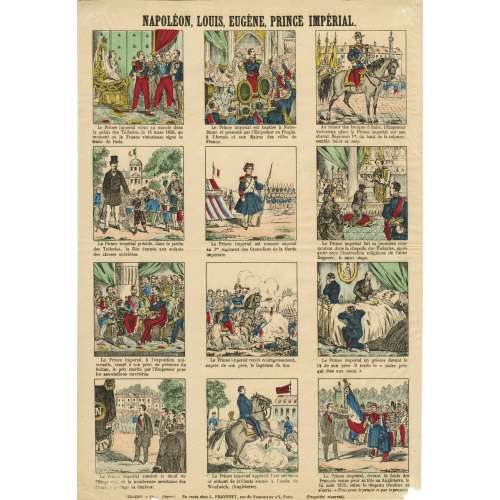 Hand-coloured woodcut on wove paper, 400 x 277 mm. Top: "NAPOLÉON, LOUIS, EUGÈNE, PRINCE IMPÉRIAL"; bellow 12 captioned frames:
Hand-coloured woodcut on wove paper, 400 x 277 mm. Top: "NAPOLÉON, LOUIS, EUGÈNE, PRINCE IMPÉRIAL"; bellow 12 captioned frames:- Le Prince impérial vient au monde dans le palais des Tuileries, le 16 mars 1856, au moment où la France victorieuse signe le traité de Paris.
- Le Prince impérial est baptisé à Notre-Dame et présenté par l'Empereur au Peuple, à l’Armée et aux Maires des villes de France.
- Au retour des troupes d'Italie, l'Empereur victorieux place le Prince impérial sur son cheval. Napoléon Ier, du haut de la colonne, semble bénir sa race.
- Le Prince impérial préside, dans le jardin des Tuileries, la fête donnée aux enfants des classes ouvrières.
- Le Prince impérial est nommé caporal au 1er régiment des Grenadiers de la Garde impériale.
- Le Prince impérial fait sa première communion dans la chapelle des Tuileries, après avoir reçu l'instruction religieuse de l'abbé Deguerry, le saint otage.
- Le Prince impérial, à l'exposition universelle, remet à son père. en présence du Sultan, le prix mérité par l'Empereur pour les associations ouvrières.
- Le Prince impérial reçoit courageusement, auprès de son père, le baptême du feu.
- Le Prince impérial en prières devant le lit de son père. Il récite le « notre père qui ètes aux cieux. »
- Le Prince impérial conduit le deuil de l'Empereur, et la nombreuse assistance des Français portage sa douleur.
- Le Prince impérial apprend l’art militaire et obtient de brillants succès à l'écolo de Woolwich, (Angleterre).
- Le Prince impérial, devant la foule des Français venus pour sa fête en Angleterre, le 15 out 1873, salue le drapeau tricolore et s'écrie : « Tout pour le peuple et par le peuple… »
-
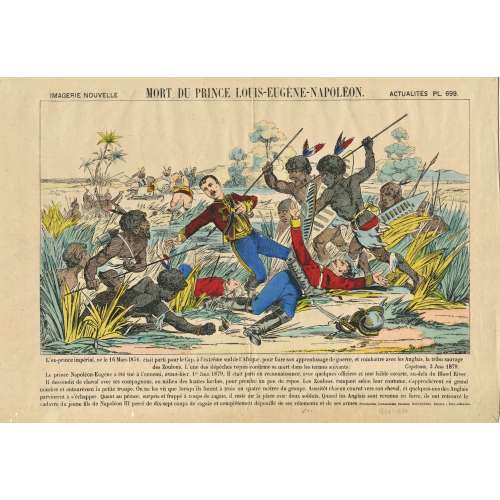 Hand-coloured lithography on wove paper, 275 x 385 mm; vertical centerfold, image in frame. On reverse: black ink stamp “5350”. Above the frame: "IMAGERIE NOUVELLE — MORT DU PRINCE LOUIS-EUGÈNE-NAPOLÉON. — ACTUALITÉS PL. 699". Under the frame: "L'ex-prince impérial, né le 16 Mars I856, était parti pour le Cap, à l'extrême sud de l'Afrique, pour faire son apprentissage de guerre, et combattre avec les Anglais, la tribu sauvage des Zoulous. L'une des dépêches reçues confirme sa mort dans les termes suivants: — Capetown, 3 Juin 1879. — Le prince Napoléon-Eugène a été tué à l'ennemi, avant-hier, 1er Juin 1879, Il était parti en reconnaissance, avec quelques officiers et une fable escorte, au-delà du Blood River. Il descendit de cheval ave ses compagnons, au milieu des hautes herbes, pour prendre un peu de repos. Les Zoulous, rampant selon leur coutume, s'approchèrent en grand nombre et entourèrent la petite troupe. On ne les vit que lorsqu' ils furent à trois ou quatre mètres du groupe. Aussitôt chacun court vers son cheval, et quelques-uns des Anglais parvinrent à s'échapper. Quant au prince, surpris et frappé à coups de zagaie, il resta sur la place avec deux soldats. Quand les Anglais sont revenus en force, ils ont retrouvé le cadavre du jeune fils de Napoléon III percé de dix-sept coups de zagaie et complétement dépouillé de ses vêtements et de ses armes". — "Typographie, Lithographie, Imagerie, Haguenthal, Éditeur à Pont-à-Mousson". Pencil ms: "1860-1880". Élie Haguenthal (French, 1822 – 1881) – publisher/printer.
Hand-coloured lithography on wove paper, 275 x 385 mm; vertical centerfold, image in frame. On reverse: black ink stamp “5350”. Above the frame: "IMAGERIE NOUVELLE — MORT DU PRINCE LOUIS-EUGÈNE-NAPOLÉON. — ACTUALITÉS PL. 699". Under the frame: "L'ex-prince impérial, né le 16 Mars I856, était parti pour le Cap, à l'extrême sud de l'Afrique, pour faire son apprentissage de guerre, et combattre avec les Anglais, la tribu sauvage des Zoulous. L'une des dépêches reçues confirme sa mort dans les termes suivants: — Capetown, 3 Juin 1879. — Le prince Napoléon-Eugène a été tué à l'ennemi, avant-hier, 1er Juin 1879, Il était parti en reconnaissance, avec quelques officiers et une fable escorte, au-delà du Blood River. Il descendit de cheval ave ses compagnons, au milieu des hautes herbes, pour prendre un peu de repos. Les Zoulous, rampant selon leur coutume, s'approchèrent en grand nombre et entourèrent la petite troupe. On ne les vit que lorsqu' ils furent à trois ou quatre mètres du groupe. Aussitôt chacun court vers son cheval, et quelques-uns des Anglais parvinrent à s'échapper. Quant au prince, surpris et frappé à coups de zagaie, il resta sur la place avec deux soldats. Quand les Anglais sont revenus en force, ils ont retrouvé le cadavre du jeune fils de Napoléon III percé de dix-sept coups de zagaie et complétement dépouillé de ses vêtements et de ses armes". — "Typographie, Lithographie, Imagerie, Haguenthal, Éditeur à Pont-à-Mousson". Pencil ms: "1860-1880". Élie Haguenthal (French, 1822 – 1881) – publisher/printer. -
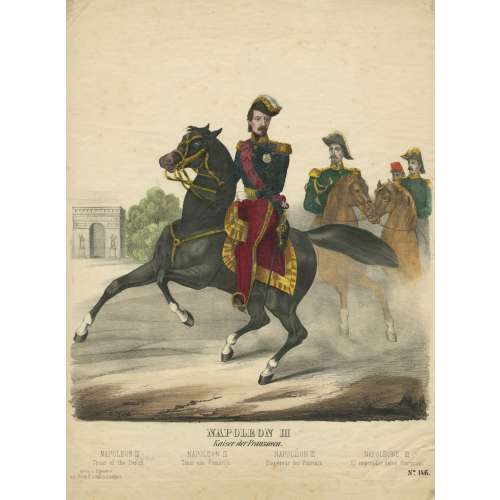 Hand-coloured lithography on wove paper 423 x 332 mm; On reverse: black ink stamp “4956”, ms “A”, ms pencil “428” and “Ernest”. Under the image, centre: "NAPOLEON III | Kaiser der Franzosen." Velow: | NAPOLEON III | Czaar of the French — NAPOLEON III | Czaar van Frankrijk — NAPOLÉON III | Empereur des Francais. — NAPOLEONE III | El emperador delos Franceses; bottom left: "Verlag u. Eigenthum | von. Fried. G. Schulz in Stuttgart.", right: "No 146." The artist's and printer's names in stone are not legible. Published in Stuttgart by Friederich Gustav Schulz (German, 1786 – 1859) during the time of the Second French Empire (1852-1870).
Hand-coloured lithography on wove paper 423 x 332 mm; On reverse: black ink stamp “4956”, ms “A”, ms pencil “428” and “Ernest”. Under the image, centre: "NAPOLEON III | Kaiser der Franzosen." Velow: | NAPOLEON III | Czaar of the French — NAPOLEON III | Czaar van Frankrijk — NAPOLÉON III | Empereur des Francais. — NAPOLEONE III | El emperador delos Franceses; bottom left: "Verlag u. Eigenthum | von. Fried. G. Schulz in Stuttgart.", right: "No 146." The artist's and printer's names in stone are not legible. Published in Stuttgart by Friederich Gustav Schulz (German, 1786 – 1859) during the time of the Second French Empire (1852-1870). -
 Offset lithography in back ink on paper, 448 x 448 mm, description by OMCA COLLECTIONS (Oakland Museum of California): The top edge of the poster has a stylized drawing of an eagle. Below, the poster has a drawing with eight male police officers and two female figures: one with the crown and torch of the Statue of Liberty, the other holding scales and wearing a blindfold in the style of personifications of justice. In the foreground of the drawing, one of the police officers is holding the liberty figure on the ground and raping her while a second officer holds one of her legs. In the background, the justice figure is being held up and raped by two officers. The rest of the police officers look at this scene and laugh or pat one another on the back. The bottom of the drawing is bordered by a semicircle of text that reads: "...WITH LIBERTY AND JUSTICE FOR ALL." [...] This provocative poster was described at a 1968 House Un-American Activities Committee (HUAC) hearing as "one of the most vile, obscene pieces of literature that I have seen disseminated in San Francisco" by San Francisco Examiner reporter Edward S. Montgomery. Contributors: Frank Cieciorka (American, 1939 – 2008) – artist.
Offset lithography in back ink on paper, 448 x 448 mm, description by OMCA COLLECTIONS (Oakland Museum of California): The top edge of the poster has a stylized drawing of an eagle. Below, the poster has a drawing with eight male police officers and two female figures: one with the crown and torch of the Statue of Liberty, the other holding scales and wearing a blindfold in the style of personifications of justice. In the foreground of the drawing, one of the police officers is holding the liberty figure on the ground and raping her while a second officer holds one of her legs. In the background, the justice figure is being held up and raped by two officers. The rest of the police officers look at this scene and laugh or pat one another on the back. The bottom of the drawing is bordered by a semicircle of text that reads: "...WITH LIBERTY AND JUSTICE FOR ALL." [...] This provocative poster was described at a 1968 House Un-American Activities Committee (HUAC) hearing as "one of the most vile, obscene pieces of literature that I have seen disseminated in San Francisco" by San Francisco Examiner reporter Edward S. Montgomery. Contributors: Frank Cieciorka (American, 1939 – 2008) – artist. -
 Colour (tone) lithography, image 396 x 508 mm, sheet 532 x 654 mm; before signature, undated; pencil ms inscription: Föhrenhain — E. Pelikan / 200M to the lower-right corner of the sheet. Contributor: Emilie Mediz-Pelikan (Austrian, 1861 – 1908) – artist. Seller's description: Austrian-German painter and graphic artist. Emilie Mediz-Pelikan was born in Vöcklabruck in 1861. She studied at the Vienna Academy and followed her teacher Albert Zimmermann to Salzburg and in 1885 to Munich. In 1891 she married the painter and graphic artist Karl Mediz (1868 - 1945), with whom she lived in Vienna and from 1894 in Dresden. She was in contact with the Dachau Artists' Colony and went on study trips to Paris, Belgium, Hungary and Italy. In the Dachau artists' colony she was friends with Adolf Hölzel and Fritz von Uhde. In 1889 and 1890 she spent time in Paris and in the Belgian artists' colony Knokke. In 1898 she was represented at the first art exhibition of the Vienna Secession, and in 1901 at the International Art Exhibition in Dresden. In 1903 she and her husband had a group exhibition, at the Hagenbund in Vienna. In 1904, she showed graphic works at the Dresden royal court art dealer Richter, and in 1905 and 1906 she exhibited at the Berlin Künstlerhaus. It was not until around 1900 that she achieved her artistic breakthrough with her landscape paintings. Since the estate of the artist, who died prematurely in Dresden in 1908, was lost in the former GDR until the 1980s, it was quite late that the artist was rediscovered and revalued both in Austrian art history and on the art market. In 1986, the first major exhibitions took place at the Upper Austrian State Museum and the University of Applied Arts in Vienna, followed by numerous smaller exhibitions in private galleries in Vienna, Linz and Munich. The artist received recognition during her lifetime from numerous prominent fellow painters as well as from the art critic Ludwig Hevesi. Together with Tina Blau, Herbert Boeckl, Marie Egner, Theodor von Hörmann, Franz Jaschke, Eugen Jettel, Ludwig Heinrich Jungnickel, Rudolf Junk, Gustav Klimt, Oskar Kokoschka, Johann Victor Krämer, Heinrich Kühn, Carl Moll, Rudolf Quittner, Rudolf Ribarz, Emil Jakob Schindler, Max Suppantschitsch, Max Weiler, Olga Wisinger-Florian and Alfred Zoff, she was a protagonist of the reception of Impressionism in Austria. This style went down in Austrian art history under the term "Stimmungsimpressionismus".
Colour (tone) lithography, image 396 x 508 mm, sheet 532 x 654 mm; before signature, undated; pencil ms inscription: Föhrenhain — E. Pelikan / 200M to the lower-right corner of the sheet. Contributor: Emilie Mediz-Pelikan (Austrian, 1861 – 1908) – artist. Seller's description: Austrian-German painter and graphic artist. Emilie Mediz-Pelikan was born in Vöcklabruck in 1861. She studied at the Vienna Academy and followed her teacher Albert Zimmermann to Salzburg and in 1885 to Munich. In 1891 she married the painter and graphic artist Karl Mediz (1868 - 1945), with whom she lived in Vienna and from 1894 in Dresden. She was in contact with the Dachau Artists' Colony and went on study trips to Paris, Belgium, Hungary and Italy. In the Dachau artists' colony she was friends with Adolf Hölzel and Fritz von Uhde. In 1889 and 1890 she spent time in Paris and in the Belgian artists' colony Knokke. In 1898 she was represented at the first art exhibition of the Vienna Secession, and in 1901 at the International Art Exhibition in Dresden. In 1903 she and her husband had a group exhibition, at the Hagenbund in Vienna. In 1904, she showed graphic works at the Dresden royal court art dealer Richter, and in 1905 and 1906 she exhibited at the Berlin Künstlerhaus. It was not until around 1900 that she achieved her artistic breakthrough with her landscape paintings. Since the estate of the artist, who died prematurely in Dresden in 1908, was lost in the former GDR until the 1980s, it was quite late that the artist was rediscovered and revalued both in Austrian art history and on the art market. In 1986, the first major exhibitions took place at the Upper Austrian State Museum and the University of Applied Arts in Vienna, followed by numerous smaller exhibitions in private galleries in Vienna, Linz and Munich. The artist received recognition during her lifetime from numerous prominent fellow painters as well as from the art critic Ludwig Hevesi. Together with Tina Blau, Herbert Boeckl, Marie Egner, Theodor von Hörmann, Franz Jaschke, Eugen Jettel, Ludwig Heinrich Jungnickel, Rudolf Junk, Gustav Klimt, Oskar Kokoschka, Johann Victor Krämer, Heinrich Kühn, Carl Moll, Rudolf Quittner, Rudolf Ribarz, Emil Jakob Schindler, Max Suppantschitsch, Max Weiler, Olga Wisinger-Florian and Alfred Zoff, she was a protagonist of the reception of Impressionism in Austria. This style went down in Austrian art history under the term "Stimmungsimpressionismus".


